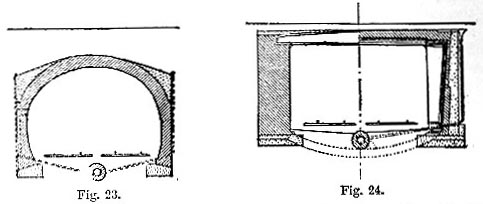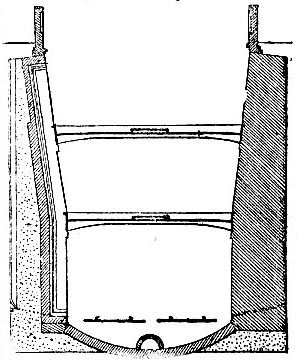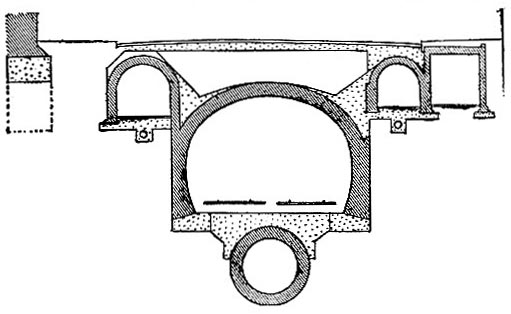1902 Encyclopedia > Railway, Railways (Railroad) > Metropolitan Railways: London Inner Circle; Covered Ways, Tunnels, etc.; Inner Circle; Glasgow City and District Railway.
Railway, Railways
(Part 24)
D. METROPOLITAN RAILWAYS
Metropolitan Railways: London Inner Circle; Covered Ways, Tunnels, etc.; Inner Circle; Glasgow City and District Railway.
London Inner Circle
Railways designed for the local service of large cities are necessarily either sunk below or raised above the level of the streets. The late Mr. Charles Pearson, solicitor to the City of London, was the originator of the system of intra-metropolitan railways. He worked at the subject from the year 1837. The Metropolitan and the Metropolitan District Railways in and around London are examples of the underground system. In 1854 the first Act of Parliament was passed; the works were commenced in 1860; the first section of the line—Paddington to Farringdon Street—was opened in January 1863, Mr. John Fowler being the engineer. Several consecutive extensions into the City and towards Westminster and the Mansion House were made at different times, until the "inner circle" was completed in October 1884, thirty years after the passing of the first Act, and twenty-four years after the commencement of the work of construction. The inner circle of railways as constructed is the direct outcome of the recommendation of the Lords’ Committee of 1863, that they should about upon, if they did not actually join, nearly all the principal railway termini in the metropolis, completing the circle by a line on the north side of the Thames. The total length of the inner circle is 13 miles and 176 yards. About 2 miles of this length are laid with four lines of rails, and there are twenty-seven stations on the circle at an average distance of half a mile apart. The combined length of the two systems, including the extensions beyond the inner circle, amounted in December 1883 to 40 miles.
The cost of the Metropolitan Railway system, 22 miles in length, in December 1883 has already been stated as £500,000 per mile, and that of the Metropolitan District Railway system, 18 miles in length, as £374,000 per mile. In 1871, when the works had been completed and opened from Moorgate Street to Mansion House station, the capital expenditure by the District Railway Company for works and equipment of 7 1/4 miles of double-line railway was officially stated to be £5,147,000; and by the Metropolitan Railway Company £5,856,000 on 10 1/4 miles,—subject to deduction in respect of surplus lands. The combined cost for 17 1/2 miles was at the rate of £630,000 per mile—the greater cost per mile being, no doubt, due to the greater proportion of underground work. The cost of the 1 1/8 miles recently opened between Mansion House and Aldgate stations was about £450,000, or about £400,000 per mile. The longer axis of the inner circle is about 5 1/3 miles in length, east and west, and the shorter about 2 miles long at the widest part, north and south. The line runs at very various levels, traversing the sloping ground that stretches from the river Thames towards the heights of Hampstead and Highgate. Several natural sewers, formerly clear brooks or tidal channels, now covered, are traversed by the railway. They occasioned many difficulties and great outlay, as they required to be conveyed across the line in specially constructed conduits. The Renelagh sewer, for instance, is carried under the Metropolitan Railway at Gloucester Terrace in a brick-built channel 9 feet wide by 8 high; and over the District Railway at Sloane Square station in a cast-iron tube 9 feet in diameter, supported on wrought-iron girders of 70 feet span. The Fleet Ditch had to be crossed five times. The average level of the rails of the District Railway, which traverses the old bed of the river and the swamps of Pimlico and Bridge Creek, is 13 feet below Thames high-water mark; whilst that of the northern part, on the Metropolitan Railway, is 60 feet above that datum, making 73 feet of difference of level, and giving rise to heavy works and steep gradients at the west and east ends of the circle. Cuttings 42 feet deep and a tunnel 421 yards in length are found at Campden Hill on the west; and cuttings 33 feet deep and a tunnel 728 yards in length at Clerkenwell on the east, on gradients of 1 in 75 and 1 in 100 respectively.
Covered Ways, Tunnels, etc.
The works of construction consist of covered ways, tunnels, and open cuttings with retaining walls. The cost of property precluded the use of ordinary open cuttings with slopes. The covered ways were formed by making open cuttings in the first place and then building "open" or artificial tunnels, and covering them in, so as to restore the surface. The sides of the cuttings were made vertical or nearly vericial, and they were supported by timber framing or poling boards till the masonry of the tunnel was completed. The line from Paddington to Moorgate was made in this way with a mixed gauge—that is, the 7 feet gauge and the 4 feet 8 1/2 inch gauge in combination—to take the traffic of the Great Western Railway as well as that of national gauge lines. The covered way was therefore made 28 1/2 feet wide and 17 high for the mixed gauge, and the arch is elliptical, built of seven "rings" or courses of brick, wide side wall three bricks or 27 inches thick, on footings 4 feet wide. At the junction of a branch with the main line a "bell-mouth" or expanding arch was constructed in which the span was gradually enlarged to 60 feet. The covered way on the extension, where the national gauge alone was laid, was 25 feet wide. The normal or standard type of arched covered way is 15 feet 9 inches high above the level of the rails. The side walls are three bricks or 27 inches in thickness, and the backs of the walls are carried down vertically to the formation. The arch was ordinarily built with five rings of bricks, making 22 1/2 inches of thickness; but the number of rings was increased occasionally to eight, nine, or ten rings. The haunches of the arch are backed with concrete. The footings of the walls rest on concrete foundations 30 inches in thickness. A drain-pipe 18 inches in diameter is laid longitudinally along the middle of the tunnel. The whole of the tunneling of the District Railway, of which Mr. Fowler was the engineer, was put in with open cuttings. Two trenches 6 feet wide were sunk to receive the side wall, which were built up to a level 4 feet above the springing of the arch. As the construction of the walls proceeded the timbering was removed and replaced by concrete backing behind the walls. The earth in the middle, called the "dumpling" or core, was excavated to such a level as to admit of the centering being put into position for the turning of the arch. When the arch was built and the centering removed, the dumpling, which had been utilized for transport, was excavated down the floor-level form ends, whence the stuff was conveyed away. By this economical method of procedure the only earth and gravel that required to be lifted was that was excavated in forming the trenches for the side walls. It was raised by means of steam-cranes travelling on temporary rails laid by the sides of the excavations. Again, the centering for the arch was supported on the core, and was simple and less costly than ordinary centering.

Fig. 23. Metropolitan District Railway. Type section of covered way - brick arch.
Fig. 24. Metropolitan District Railway. Type section of covered way.
The complete arch is shown in section in fig. 23. Inverts, or inverted arches, where laid in across the bottom, between the footings of the walls, where, from the nature of the soil or from excessive lateral pressure, the floor was thought likely to rise. When there was not sufficient depth for a brick arched way the side walls were made, as shown in fig. 24, of brick and concrete, in bays 8 feet wide, of piers and recesses, spanned by cast-iron girders from 18 to 30 inches in depth, carrying jack-arches between them. The average cost of the arch-covered ways, 25 feet wide, was about £40 per lineal yard, as against £52 per yard for the girder-covered way.
Inner Circle
On the inner circle there are three tunnels,—the Clerkenwell tunnel, 728 yards long, of which the level of the rails was from 20 to 59 feet below the surface of the ground; the "widening" tunnel, 733 yards long, parallel to the Clerkenwell tunnel; and the tunnel under Campden Hill, 421 yards in length. Even when the utmost precautions are taken, tunneling through a town is a risky operation. Settlements may occur years after the completion of the works; water mains may be broken in the streets and in the houses; stone staircases may fall down; and other unpleasant symptoms of instability may show themselves. The cost of the tunnel of 25 feet in width was at the rate of £63 per lineal yard. Open cuttings are 28 1/2 feet in clear width on the original line of mixed gauge and 25 feet wide on the extensions. The retaining walls are of brick and concrete, in 11 feet bays, consisting of piers 3 feet wide on the face, and recesses between the piers 8 feet wide. They are inclined backwards with a batter of 1 1/2 inches to 1 foot. The foundations are 5 feet below the level of the rails, and the thickness of the walls at the base is 40 per cent, or two-fifths of the height. Occasionally, where the depth is considerable, the thickness is less, and one or two rows of cast-iron struts, according to the depth, are placed between the walls at the upper part to take the thrust.

Fig. 25. Metropolitan District Railway. Type section of open cutting.
A section of open cutting with two rows of struts is shown in fig. 25. The cost of open cuttings 25 feet wide and 25 deep was, say, £67 per lineal yard, or with one row of cast-iron struts £55 per yard. With two rows of struts for a depth of 42 feet, the cost was £108 per lineal yard. It was the intention originally to make the stations as well as the railway strictly "underground," and those at Baker Street, Portland Road, and Gower Street were so constructed. At Baker Street a segmental arch of 4 feet span and 10 feet 4 inches of rise extends over the entire length of platform. The cost of such a station, including booking-offices, restorations, and other contingencies, amounted to £18,000. On the extensions the stations were, when the conditions admitted it, placed in open cuttings, roofed over, 300 feet long, with platforms 15 feet wide. The average cost exceeded that of the same length of ordinary covered way by from £14,000 to £22,000. Not only sewers but gas mains and water mains occasionally demanded very expensive diversions. In passing Broad Sanctuary 2000 feet of gas mains, ranging from 14 to 30 inches in diameter, were diverted; and in simply crossing High Street, Kensington, 600 feet of pipes of from 3 to 30 inches bore were diverted. In passing a sound building on a good foundation the work was executed in short lengths, with carefully timbered trenches quickly followed up by the concrete and brickwork of the retaining walls or covered way. Under the houses of Pembridge Square the side walls f the railway were constructed in short lengths, and to form the roof of the covered way main girders of 25 feet span were slipped between the walls of the houses at convenient places, between which jack-arches were built. At Park Crescent only a floor of old ship timber separates the kitchen from the railway. The permanent way originally consisted of wrought-iron flange rails wit longitudinal sleepers and then of steel flange rails; but these have been gradually replaced by double-headed rails in chairs.

Fig. 26.
Fig. 26 shows a section of the covered way under Queen Victoria Street, with the main sewer underneath and the galleries for pipe, &c., at the sides.
Glasgow City and District Railway
The Glasgow City and District Railway will supply important links of communication between the railways on the north side of the river Clyde. The line extends from College station, High Street, by George Street and Regent Street, crossing Dumbarton Road to the existing Stobcross line, over a length of nearly 2 1/2 miles, almost wholly underground. Of this length 1700 yards, or nearly 1 mile, are tunnelled and 1000 yards are covered way. The tunnels are arched with four rings of brick in cement, to a clear height of 18 1/2 feet at the crown and 27 feet in width, for two lines of way. The covered way is arched over with brick.
Read the rest of this article:
Railway, Railways - Table of Contents
|


